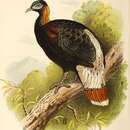Biology
provided by Arkive
Sclater's monal is solitary during the breeding season (spring), but gregarious in winter (5). However, the breeding behaviour of this pheasant is poorly understood, with very little information from either wild or captive conditions (6). Clutches have been found in April, May and June (6), and more than one clutch of five eggs has been reported (2).
Very little is known about this species' feeding habits, other than that Polygonum seeds and flower-heads have been found in the diet. In China, rhizomes of ferns, bamboo leaves and other unspecified leaves are all reportedly consumed, while the newly discovered race in Arunachal Pradesh, India, was observed feeding on the underground tubers of the cobra lily (Arisaema) (6).
Conservation
provided by Arkive
Sclater's monal is legally protected in China (a first class nationally protected species), India (Schedule 1 of the Wildlife Act 1972) and Myanmar (List of protected species 1994) (6). The species also occurs in the Gaoligong Shan National Nature Reserve and Nu Jiang Nature Reserve in China, the Medog National Nature Reserve and Chayu Nature Reserve in Tibet, and the Dehang-Debang Bioshpere Reserve in Arunachal Pradesh, India, which encompasses the Dibang Valley Wildlife Sanctuary, Mouling National Park and unclassified state forests (5) (6). Fortunately, although there appears to have been a long tradition of hunting and egg-collection in the mountains between India and China, the altitudes at which this pheasant lives and the inaccessibility of much of its range probably protect it from excessive hunting (6).
Description
provided by Arkive
Like other monals (Lophophorus spp.), Sclater's monal is a spectacularly colourful bird, boasting shimmering metallic green, blue, purple and black upperparts, a bluish-green crown, metallic coppery-bronze neck and blue facial skin (4). A distinctive feature of this species is the white feathers of the lower back and rump, which extend into a broad chestnut band on the tail, tipped in white (although the tail is completely white in a recently discovered population in Arunachal Pradesh, India) (4) (5). Males of this species also differ from other monals in having no obvious crest, just short, curly crown feathers (2) (4) (5). The female is brown with fine barring of dark brown and buff on the breast, and is generally darker than other monals, with a broader white tail tip and no crest (4) (5).
Habitat
provided by Arkive
Sclater's monal occurs in coniferous forest with a bamboo understorey, subalpine rhododendron scrub, azalea forest, and areas of juniper, cotoneaster, open grass and rocky precipitous slopes. Found between 3,000 and 4,200 metres above sea level, descending to as low as 2,000 metres in winter (5).
Range
provided by Arkive
Endemic to the eastern Himalayas, from Arunachal Pradesh, India, east through north Myanmar and south-east Tibet to west Yunnan, China (5). In India a newly discovered but as yet unnamed subspecies is thought to occupy a restricted range from the eastern Tawang (Towang) district to the western Upper Subansiri district (6).
Status
provided by Arkive
Classified as Vulnerable (VU) on the IUCN Red List 2007 (1) and listed on Appendix I of CITES (3).
Threats
provided by Arkive
Habitat degradation and over-exploitation for food are thought to be the main threats to Sclater's monal across its range, while hunting for feathers to make ornaments and fans is an additional problem in India (2) (5) (6). Deforestation is considered a serious threat to the Chinese population, but commercial forest clearance poses little threat in India, since logging has been banned in relevant areas of Arunachal Pradesh. In northern Myanmar, ceasefires signed between the Yangon (Rangoon) government and rebel groups are apparently leading to increased rates of deforestation, as the groups can now coordinate logging activities and trade with China in peace. It is possible that this development will have a dramatic impact on forest availability for this species (6).
Sclater's monal
provided by wikipedia EN
Sclater's monal (Lophophorus sclateri) also known as the crestless monal is a Himalayan pheasant. The name commemorates the British zoologist Philip Lutley Sclater.[3]
Taxonomy
Sclater's monal has three recognized subspecies:[4]
-
L. s. arunachalensis (Kumar & Singh, 2004)
- L. s. orientalis (Davison G.W.H., 1974)
-
L. s. sclateri (Jerdon, 1870)
Description
Sclater's monal is a large, approximately 68 centimetres (27 in) long, monal pheasant. As with other monals, the male is a colourful bird. It has a highly iridescent purplish-green upperparts plumage, short and curly metallic green crown feathers, copper neck, purplish-black throat, white back, blue orbital skin, yellowish-orange bill and brown iris. In the nominate subspecies, the tail is white with a broad chestnut band, while the tail is entirely white in L. s. arunachalensis from western Arunachal Pradesh in India.[5] The crestless female is mostly a dark brown bird with a white throat and tail-tip, dull bluish orbital skin and a pale yellow bill.
Distribution and habitat
Sclater's monal is distributed to mountain forests of the east Himalayan region, in north-eastern India, south-eastern Tibet and northern Burma, at altitudes of 2,500 to 4,200 metres (8,200 to 13,800 ft).
Behaviour
The diet of the Sclater's monal, like that of other members of the genus Lophophorus, probably consists mainly of tubers, roots, bulbs, arthropods, rodents, seeds and flowers. The female usually lays between three and five eggs. It is not known if the male participates in nest defense, but it is likely.
Conservation
Due to ongoing habitat loss, small population size, limited range and overhunting in some areas for food and its feathers, Sclater's monal is evaluated as Vulnerable on IUCN Red List of Threatened Species. It is listed on Appendix I of CITES.
References

- license
- cc-by-sa-3.0
- copyright
- Wikipedia authors and editors
Sclater's monal: Brief Summary
provided by wikipedia EN
Sclater's monal (Lophophorus sclateri) also known as the crestless monal is a Himalayan pheasant. The name commemorates the British zoologist Philip Lutley Sclater.
- license
- cc-by-sa-3.0
- copyright
- Wikipedia authors and editors

